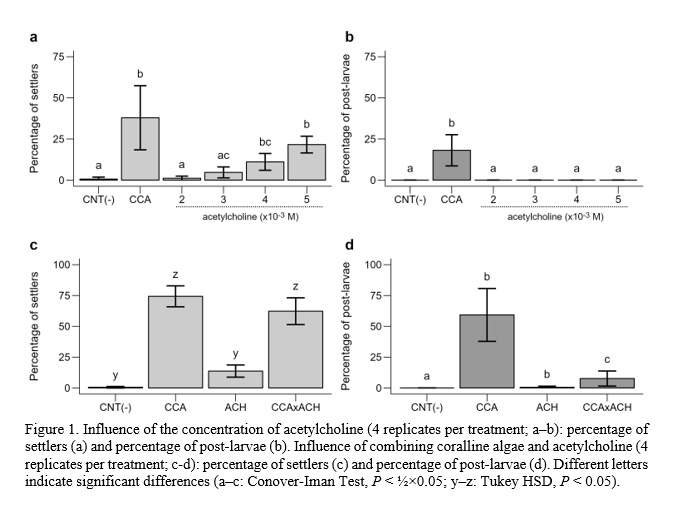ACETYLCHOLINE CONTROL OF METAMORPHOSIS IN Patella aspera
Introduction
The full-cycle aquaculture of marine invertebrates requires the metamorphosis induction of the swimming larvae into benthic post-larvae for the grow-out phase. Recent advances in limpet aquaculture used coralline algae and conditioned seawater as natural inducers (Castejón et al. 2024). Compounds with settlement inducing properties, such as acetylcholine, are easier to store and manage than natural inducers and can be applied on demand. The present research determined the influence of acetylcholine on the metamorphosis of the limpet Patella aspera.
Material and Methods
The broodstock was captured between February and March 2024 and kept in an open system (20 ± 1 °C and 36 ± 1 psu). Gametes were obtained by dissection. Then, the oocytes were matured artificially (NH4OH at pH 9 during 20–30 min.) and fertilized in vitro (105 sperm cells ml-1). Lecithotrophic larvae were cultured in glass beakers and plastic jars (16 °C).
Two assays placed pediveliger larvae 3-day old in culture wells (8 mL) and used two control treatments, filtered seawater as negative control and coralline algae as positive control . First assay tested four acetylcholine (ACH) concentrations (2 to 5×10-3 M ). Second assay tested 4×10-3 M ACH alone and a combination of 4×10-3 M ACH with coralline algae. Treatments were applied on larvae 7 and 10-day old, respectively. Assays were finished four days later. The third assay was designed to test the impact of ACH on the completion of metamorphosis. For this purpose, metamorphics ( settled specimens that just lost their velum) were obtained by exposing 10-day old larvae to coralline algae for 24h. Then, the metamorphics were exposed to filtered seawater (negative control) or 4×10-3 M ACH for three additional days.
Two settled stages were identified: metamorphics (velum loss) and post-larvae (teleoconch and head development). The percentage of settlers (metamorphics + post-larvae) determined the success in starting the metamorphosis and the percentage of post-larvae determined the success in finishing the metamorphosis.
Results and Discussion
In Assay 1, the percentage of settlers increased in parallel with the concentration of acetylcholine (Fig. 1a), but no post-larvae were observed in acetylcholine treatments (Fig. 1b).
In Assay 2, the coralline algae alone resulted in a similar percentage of settlers as coralline algae combined with acetylcholine (Fig. 1c) , but in this combined treatment the percentage of post-larvae was significantly reduced (Fig. 1d). The third assay confirmed the impact of acetylcholine on the completion of metamorphosis, as the percentage of settled specimens (metamorphics) reaching the post-larval stage (head and teleoconch development) was lower (t-test P < 0.01) when exposed to acetylcholine (69 ± 13%) than to filtered seawater (90 ± 7%).
Acetylcholinesterase is a neuronal enzyme found in both vertebrates and invertebrates involved in the hydrolysis of the neurotransmitter acetylcholine.
identified a high diversity of nicotinic acetylcholine receptor genes in molluscs, suggesting a high diversity of functions, including a likely regulation of early development. The present results supported this hypothesis, as acetylcholine promoted the start of metamorphosis in limpets (velum loss), while inhibiting the completion of metamorphosis. Since in the marine gastropod Concholepas concholepas the metamorphosis entails a new form of acetylcholinesterase
, it is congruent to postulate that the regulation of metamorphosis in marine gastropods may require the presence and posterior reduction of acetylcholine levels.
Bibliography
Castejón, D., Sousa, P. & Andrade, C. A. P. 2024. Specific settlement strategies for two exploited limpet species (Patella aspera and P. ordinaria) using coralline algae and conditioned seawater. Aquaculture, 593, 741263.
Inestrosa, N. C., González, M. & Campos, E. O. 1993. Molecular changes induced by metamorphosis in larvae of the prosobranch Concholepas concholepas Bruguiere (Mollusca; Gastropoda; Muricidae). Journal of Experimental Marine Biology and Ecology, 168, 205-215.
Jiao, Y., Cao, Y., Zheng, Z., Liu, M. & Guo, X. 2019. Massive expansion and diversity of nicotinic acetylcholine receptors in lophotrochozoans. BMC genomics, 20, 937.
